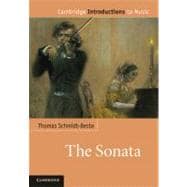
Note: Supplemental materials are not guaranteed with Rental or Used book purchases.
Purchase Benefits
What is included with this book?
| List of musical examples | p. viii |
| List of tables | p. xi |
| Preface | p. xii |
| Definitions | p. 1 |
| Sonata and canzona | p. 3 |
| Sonata and sinfonia | p. 7 |
| Sonata and concerto | p. 9 |
| Sonata and suite/partita | p. 10 |
| The sonata and free instrumental genres: toccata - ricercar - capriccio - fantasia | p. 12 |
| Summary: instrumentation, form, texture or function? | p. 15 |
| Form | p. 20 |
| The 'free' sonata in the seventeenth century | p. 20 |
| Corelli and his legacy | p. 34 |
| The sonata da chiesa | p. 36 |
| The sonata da camera | p. 41 |
| Corelli's followers in the eighteenth century | p. 47 |
| Regional traditions | p. 51 |
| Sonata cycles and 'sonata form' after 1750 | p. 53 |
| Fast movements: 'sonata form' and related categories | p. 54 |
| From dance form to sonata form | p. 55 |
| Terminology | p. 61 |
| The exposition | p. 63 |
| The development | p. 76 |
| The recapitulation | p. 82 |
| There-entry | p. 84 |
| The transition | p. 86 |
| The recapitulation as a result of events in the exposition and development | p. 87 |
| Extra options: slow introduction and coda | p. 88 |
| Sonata form - bipartite or tripartite? | p. 90 |
| Slow movements | p. 91 |
| Minuet and scherzo | p. 95 |
| Finales | p. 97 |
| Beethoven's sonatas - consummating or transcending Classical form? | p. 100 |
| Construction of themes and their elaboration | p. 103 |
| Types of theme | p. 103 |
| Thematic contrast and thematic derivation | p. 105 |
| Elaboration and transformation of themes and motives | p. 105 |
| Slow introduction and coda | p. 107 |
| Manipulations of the tonal process | p. 108 |
| Major-key recapitulation in minor-key movements | p. 108 |
| Third relations versus fifth relations | p. 110 |
| New slow-movement types | p. 111 |
| The upgrading of the dance movement | p. 113 |
| Final movements | p. 115 |
| Camouflaging the formal structure | p. 115 |
| The cycle | p. 117 |
| Sequence and combination of movements | p. 117 |
| Tonal structures | p. 119 |
| Transitions | p. 121 |
| Motivic unity and quotations | p. 122 |
| The sonata after Beethoven | p. 126 |
| Franz Schubert | p. 128 |
| Sonata composition after c. 1830 | p. 135 |
| Motivic unity - motivic derivation - developing variation | p. 140 |
| Quotation | p. 147 |
| Tonal structure | p. 149 |
| Integration on multiple levels: Schumann's Piano Sonata, Op. 11 | p. 150 |
| The amalgamation of the sonata cycle with sonata form: Franz Liszt's B minor Sonata | p. 151 |
| Sonata composition in the twentieth century | p. 157 |
| The sonata in the nineteenth-century tradition | p. 158 |
| The neo-classicist and historicist sonata | p. 163 |
| The sonata as generic 'piece for instrument(s)' | p. 165 |
| The eclectic sonata | p. 168 |
| Functions and aesthetics | p. 173 |
| Locations and occasions | p. 173 |
| Target groups: professionals, connoisseurs and amateurs | p. 177 |
| Learned style | p. 179 |
| Virtuosity | p. 182 |
| Sonata form as an aesthetic paradigm | p. 186 |
| Absolute music? On meaning and programmaticism | p. 188 |
| Scoring and texture | p. 193 |
| Developments in the seventeenth and eighteenth centuries | p. 194 |
| Number of instruments | p. 194 |
| The ensemble sonata | p. 194 |
| The sonata for small ensemble | p. 195 |
| Nature and formation of the ensemble | p. 200 |
| The scoring of the bass part | p. 204 |
| Other instruments | p. 205 |
| The paradigm shift of c. 1750 | p. 208 |
| The age of the piano sonata | p. 210 |
| Beethoven, Clementi and the nineteenth century | p. 215 |
| The piano sonata in the twentieth century | p. 219 |
| Piano and others | p. 220 |
| Melody instrument with piano or piano with melody instrument? | p. 220 |
| The duo sonata in the nineteenth century as the 'anti-virtuosic' sonata | p. 225 |
| Other instruments | p. 228 |
| Developments in the twentieth century | p. 230 |
| The sonata for unaccompanied solo instrument | p. 231 |
| The organ sonata | p. 233 |
| Notes | p. 236 |
| Select bibliography | p. 243 |
| Index | p. 250 |
| Table of Contents provided by Ingram. All Rights Reserved. |
The New copy of this book will include any supplemental materials advertised. Please check the title of the book to determine if it should include any access cards, study guides, lab manuals, CDs, etc.
The Used, Rental and eBook copies of this book are not guaranteed to include any supplemental materials. Typically, only the book itself is included. This is true even if the title states it includes any access cards, study guides, lab manuals, CDs, etc.